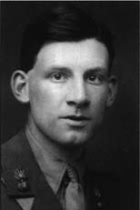
Siegfried Loraine Sassoon, the second of three sons of Alfred Ezra Sassoon and Theresa Georgina Thornycroft, was born on 8th September 1886 at Weirleigh, Matfield, near Brenchley in Kent. The Sassoons were a wealthy Baghdadi and Indian Jewish merchant family and the Thornycrofts were a notable English Catholic family of sculptors, artists and engineers. Alfred Sasson was disinherited for marrying outside the Jewish faith and after six years of marriage, when Siegfried was four, the couple separated. Five years later in 1895 Alfred Sassoon died of tuberculosis.
Siegfried was educated at Marlborough College and then Clare College, Cambridge, but in 1907 left university without a degree. For the next seven years he hunted and played cricket in Kent, and began to develop his talent for poetry, some of which he published privately.
WWI was to change Siegfried's life. After a period with the Sussex Yeomanry, Siegfried joined the 3rd Battalion, Royal Welch Fusiliers as a second lieutenant on 29th May 1915. As his battalion was preparing to leave for France, Siegfried was hit hard by the death of his younger brother Hamo on 1st November 1915 from wounds received in the Gallipoli campaign. Siegfried's bravery and leadership on the Western Front was exceptional. He was nicknamed "Mad Jack" for his exploits and was awarded the Military Cross on 27th July 1916 for conspicuous gallantry during a raid on the enemy's trenches.. In April 1917 he was wounded and during his convalescence in Oxford met with pacifist friends including Bertrand Russell. He was inspired to write Finished with the War: A Soldier's Declaration which he sent to his commanding officer and to a sympathetic M.P. who read it out in the House of Commons. It was also published in The London Times. Being a serving officer Siegfried could have faced a court martial for this defiant statement but instead the Under-Secretary of State for War sent Siegfried to Craiglockart War Hospital in Edinburgh to be treated for "shell shock" where he met and strongly influenced the war poet Wilfred Owen. Siegfried was treated by the psychiatrist W.H.R. Rivers who became a life-long friend. In 1918 Siegfried returned to active service in Palestine and then France where he was wounded again on 13th July and returned to Britain having been promoted to acting captain.
Siegfried's reputation as a war poet was secured with the publication of The Old Huntsman and Other Poems in 1917 and Counter Attack in 1919 - containing over 100 realistic and compassionate poems about the war. Throughout the 1920s he published numerous collections of poems, dabbled in politics and toured extensively in the U.S.A. and Europe. In 1928 he published his first novel - Memoirs of a Fox-Hunting Man - a fictionalised autobiography about his early years in Kent where he figures as the narrator George Sherston. The novel was an immediate success and won the Hawthornden and James Tait Black memorial prizes. Two more fictionalised autobiographies followed Memoirs of an Infantry Officer (1930) and Sherston's Progress (1936). Later in life Siegfried would write his genuine autobiography in three volumes - The Old Century and Seven More Years (1938), The Weald of Youth (1942) and Siegfried's Journey (1945) and then in 1948 published a biography of George Meredith. Throughout this period until the 1960s he continued writing and publishing his poetry. In the 1951 New Years Honours he was made Companion of the British Empire.
Siegfried's personal life after the war is marked by his search for a life-time companion. He also began to express his homosexuality more openly as he conducted a series of unsuccessful affairs with a number of his artistic and aristocratic friends. In 1931 Siegfried moved to Wiltshire where he was to stay for the rest of his life and in 1933, to the surprise of many, he married Hester Gatty who was twenty years his junior. They bore one child George Thornycroft Sassoon (1936-2006) who became a scientist, linguist and author. The marriage broke down in 1945. In 1957 Siegfried converted to Roman Catholicism and he paid regular visits thereafter to the nuns at Stanbrook Abbey who printed some of his later work.
Seigfried Sassoon died on 1st September 1967 one week before his 81st birthday of stomach cancer. He is buried at St Andrew's Church, Mells, Somerset. On 11th November 1985, Siegfried was among sixteen Great War poets commemorated on a slate stone unveiled in Westminster Abbey's Poet's Corner. The inscription, written by Wilfred Owen, reads:
"My subject is War, and the pity of War. The Poetry is in the pity."
| Generation No. 1 | |||
| 1. Siegfried Loraine Sassoon, C.B.E., M.C., Poet and Novelist was the son of Alfred Ezra Sassoon, financier and sculptor and Theresa Georgina Sassoon [Thornycroft]. He was born 8th Sep 1886 at Weirleigh, Matfield, Kent, registered at Tonbridge District, Kent, ref: 1886 Q4 Vol 2a Page 675; died 1st Sep 1967 at Heytesbury, Wiltshire, aged 80 years; buried after 1st Sep 1967 at St Andrew's churchyard, Mells, Somerset | |||
| He married Hester Gatty on Dec 1933 at Christchurch, Hampshire. She was born Apr to June 1906, registered at Kensington District, London, ref: 1906 Q2 Vol 1a Page 157; died 1973. They had the following children: | |||
| i | George Thornycroft who was born 30th Oct 1936 at London; died 8th Mar 2006 | ||
The Weald is at Database version 14.05 which has ongoing updates to the 395,000 people; 9,000 places; 613 maps; 3,308 pictures, engravings and photographs; and 248 books loaded in the previous version